The Five Main Muscles for a Full Range of Natural Movement, Dynamic Alignment & Balance.
post by leggi · 2019-09-01T03:22:38.247Z · LW · GW · 10 commentsContents
Introduction Do you move well? Our System For Movement. Do you have a full range of natural movement? A Full Range of Natural Movement. Anatomy of alignment and balance (recap): The 5 Main Muscles of Movement are: 1. Pelvic Floor. My comments. 2. Rectus Abdominis. My comments. 3. Gluteus Maximus. My comments. 4. Rectus Femoris. My comments. 5. Trapezius. 1. Upper trapezius. (a.k.a. superior trapezius, descending trapezius) 2. Middle trapezius. (a.k.a. transverse trapezius) 3. Lower trapezius. (a.k.a. inferior trapezius, ascending trapezius) My comments. Base-Line Theory of Health and Movement (part 1). Everything starts from your Base-Line muscles: Pelvic floor - Base. Rectus abdominis - Line. Connect Your Base-Line to Your Legs. Gluteus maximus & rectus femoris. Connect Your Base-Line to Your Upper Body. Trapezius. A Simple Technique - Breathing with your Base-Line. Background Notes on Muscles: Muscle Engagement & Activation. Muscle Cells = Muscle Fibres. Areas of Muscle. Voluntary Muscles. Test Yourself ... To balance the body. And mind. There are many idiopathic (of unknown cause) symptoms and syndromes associated with chronic pain. No known cause means no effective treatment. No relief for those who suffer. I believe that only when the main muscles of movement are being used correctly can their dysfunction be ruled out as the ... None 10 comments
Epistemic status. Full confidence. The anatomy is easily verifiable. Working towards fully utilising these muscles has changed my life. My story here [? · GW].
For a less wordy introduction to the anatomy try here: The 5 Main Muscles Made Easy [? · GW].

Introduction
Following an introduction to our midline anatomy [LW · GW] and the median plane [LW · GW] as the references for alignment and balance of the human body, think about how you move.
Do you move well?
Our System For Movement.
The main components of our 'system for movement' are:
- Muscles (The movers - tissue of action - background notes on muscles [LW · GW].)
- Bones (Solid frame, attachment points for muscles.)
- Brain (HQ. Receiving and processing sensory information and sending commands to body.)
- Mind (Observer and controller.)
- Nerves (Communication network.)
- Connective tissues (Just about everything else). We are physically interconnected from head to fingers to toes by the body-wide web of connective tissues [LW · GW] (various forms of fibrous tissue) .
Do you have a full range of natural movement?
A Full Range of Natural Movement.
A full range of natural movement is what your body should be able to do. Your full potential. Not what you are currently able to do.
When the body is balanced, movement can flow through all potential positions. The head, arms and legs can all be moved independently, through their full range of motion, in a smooth and controlled manner, without effort or strain.
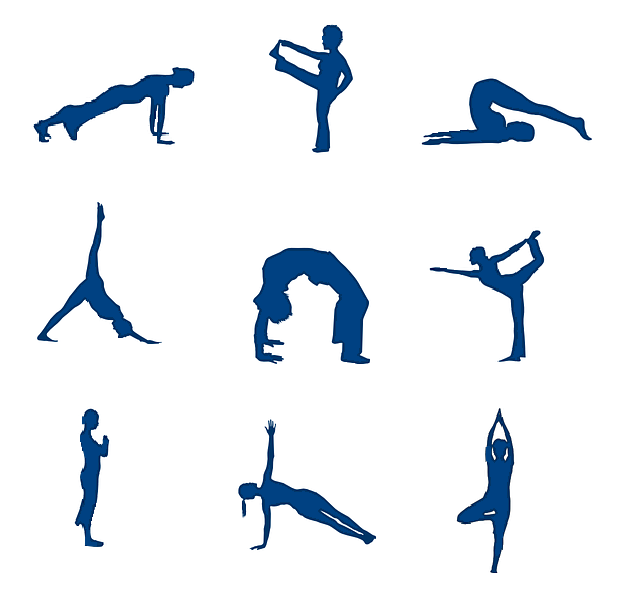
To give some an idea of what the body is capable, consider the number of moving joints of the body (I'm not happy to provide a figure but various suggestions appear here on Quora.) and the range of motion of those joints (not an exhaustive list e.g. there's no data for the spinal column). The slightest movement in any joint - flexion, extension, adduction, abduction, rotation depending on the joint's capabilities - creates a novel pose. The body has innumerable positions - our posture [LW · GW]/positioning/movement is a flow.
A full range of natural movement is possible when the body is functioning at optimal [LW · GW], dynamically balanced and aligned [LW · GW]. (baselinehealing.com what does alignment mean?)
Anatomy of alignment and balance (recap):
The linea alba [LW · GW] and nuchal & supraspinous ligaments [LW · GW] are our main anatomical guides for body alignment.

These midline structures are strips of tough connective tissue that we have no direct control over, we can however influence 2 of our components of movement - muscles and mind - and learn to work with the adjacent muscles (see below for some background notes on muscles) to:
- Increase awareness of the sensory feedback from adjacent muscles to feel the relative positioning of our midline anatomy. Developing conscious awareness of our sense of proprioception [LW · GW].
- Increase voluntary control of the relevant muscles. Focusing on activating the adjacent muscles allows us to work towards physically aligning the linea alba and nuchal & supraspinous ligaments and regaining a full range of natural movement.
Whatever exercise you do, routines, sports etc... be more aware of the positioning of your body (posture [LW · GW]) and your state of alignment by working with your "5 main muscles of movement".
According to Base-Line Theory of Health and Movement:
The 5 Main Muscles of Movement are:
1. Pelvic Floor.
(The pelvic floor consists of several muscles that can be thought of one unit.)
The "pelvic floor" are the muscles that span the pelvic canal. Also known as the pelvic diaphragm.
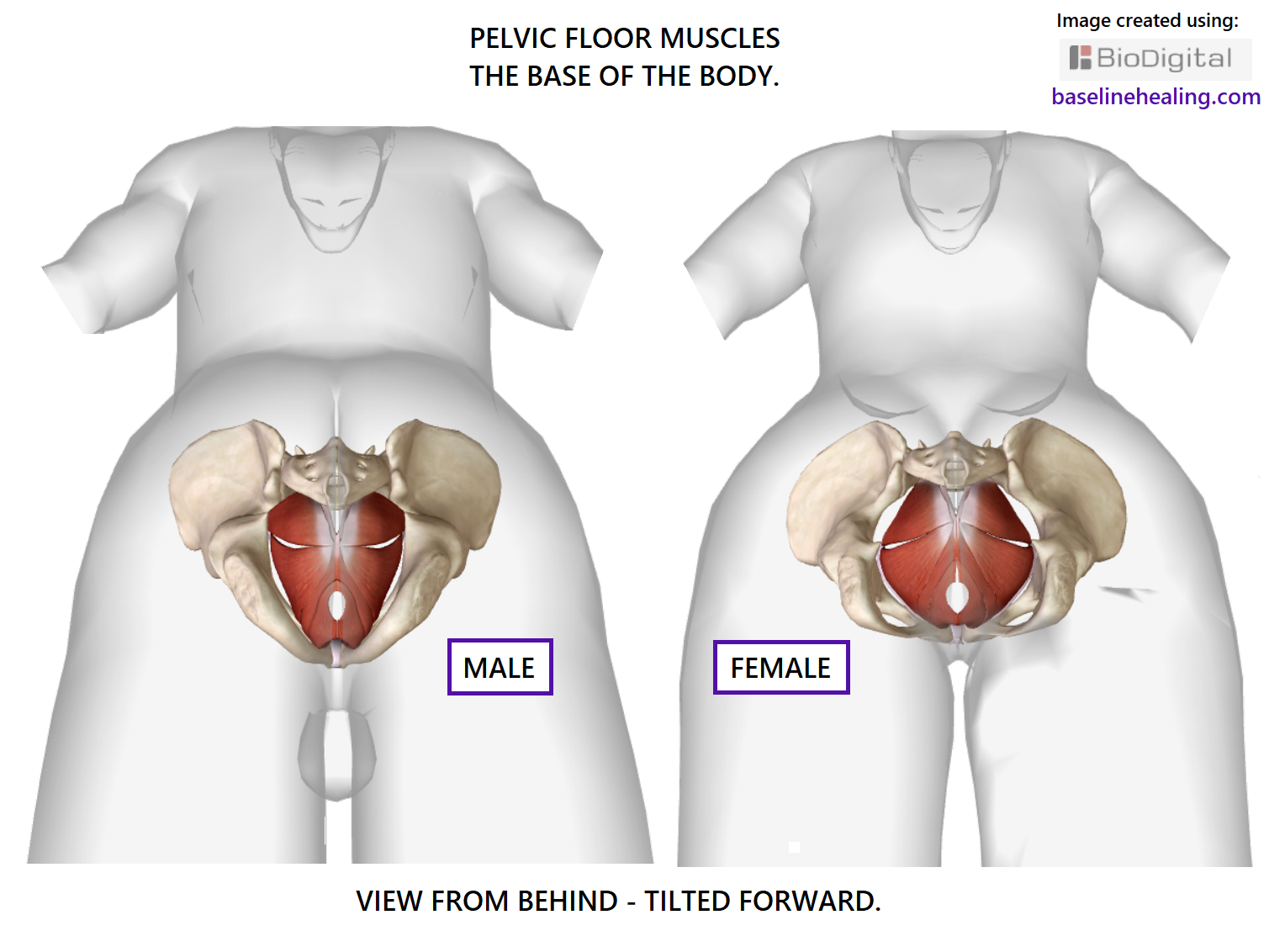
Left and right sides of the pelvic floor are a mirror image, the line of symmetry the body's midline.
The pubic symphysis (where the linea alba and rectus abdominis muscles attach to the pelvis) is located on the midline of the anterior border of the pelvic canal.
To describe the pelvic floor in detail would be time-consuming - and frustrating. The anatomy is complicated with some controversy with regards to nomenclature, and is unimportant to this process. Think of the pelvic floor muscles as one unit of two halves.

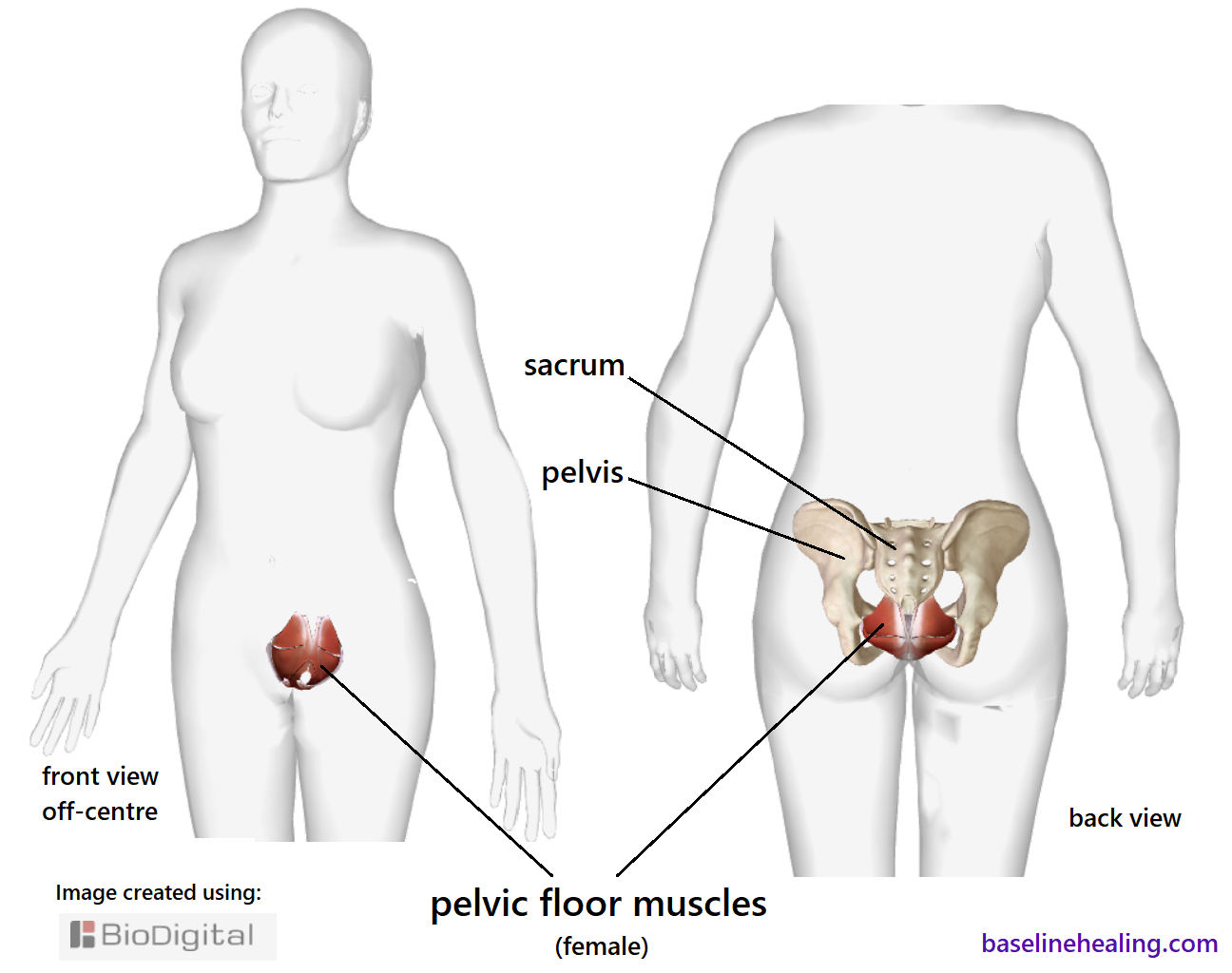
My comments.
The pelvic floor muscles - a basket of muscles that should be tight and secure.
Activate your pelvic floor muscles and think of them at the root of all movement.
The solid Base for the the rest of the body.
2. Rectus Abdominis.
The left and right rectus abdominis muscles run parallel to each other, either side of the linea alba [LW · GW], up the front of the abdomen from pelvis to thorax.
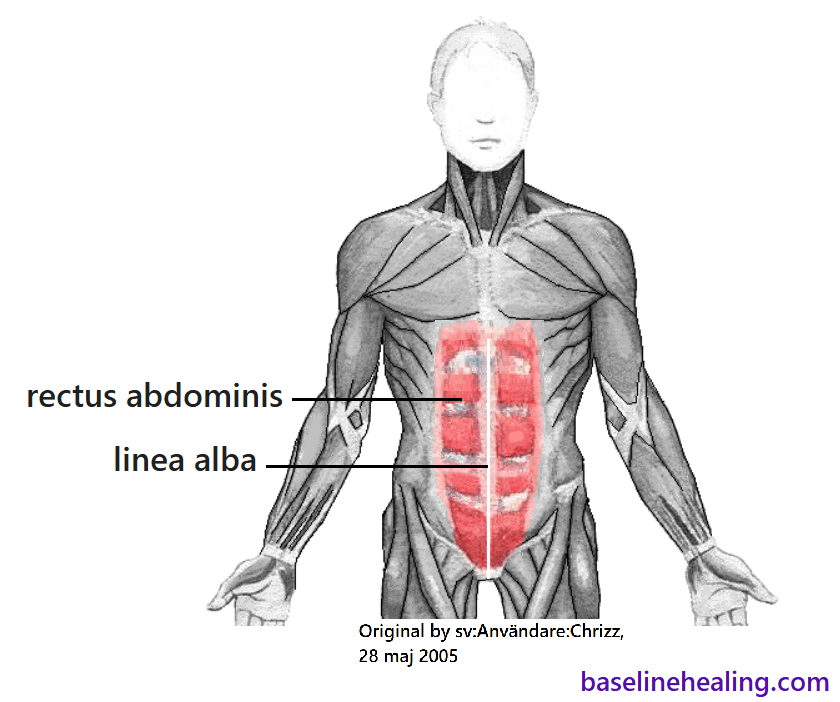
The rectus abdominis muscles attach to:
- Pubic symphysis and pubic crest of the pelvis.
- Costal cartilages of the 5th, 6th and 7th ribs (on the medial inferior costal margins).
- Posterior aspect of xiphoid process of the sternum.

The rectus abdominis muscles consists of several 'panels' of muscle between strips of connective tissue known as tendinous intersections. These sections of muscle are what gives the rectus abdominis the “6-pack” look, but the number of panels can vary between individuals - 4, 8, and 10 packs can occur.
The rectus abdominis muscles sit within their respective rectus sheath formed by the aponeuroses of the lateral abdominal muscles before they merge to form the linea alba.

My comments.
The rectus abdominis muscles - Our core pillar of strength. Our central Line. Strong and flexible, able to support the rest of the body through a full range of movement when fully utilised. Ribbons of muscle that can bend and rotate at every level.
Like two stacks of blocks to be activated in sequence from pelvis to chest.
Think longer and stronger with every in breath.
Fully engaging and elongating the rectus abdominis muscles extends the linea alba (our primary guide for alignment) to its full potential.

3. Gluteus Maximus.
Situated at the posterior of the pelvic region, the left and right gluteus maximus muscles are the largest skeletal muscles in the body. From pelvis to femur, the gluteus maximus provide stability to the hip joint when fully active.
The superficial muscle layer of the buttocks, covering and surrounded by a lot of complicated anatomy that is prone to various strains and syndromes when the gluteus maximus are not adequately functioning.

The gluteus maximus muscles attach to multiple structures, many more than the current standard description covers.
Attachments of the gluteus maximus:
- The ilium of the pelvis (posterior to the posterior gluteal line {attaching to a narrow, semilunar area with a rough surface}, and the posterior superior iliac crest.
- The sacrum (posterior inferior edge).
- The coccyx (lateral sides of the posterior surface).
- The aponeurotic fascia of the gluteus medius muscle.
- The sacrotuberous ligament (posterior surface).
- The tubero-iliac ligament (part of the long posterior {dorsal} sacroiliac ligament).
- The thoracolumbar fascia. (Through its attachment to the raphe of the thoracolumbar fascia, the gluteus maximus is coupled to the ipsilateral multifidus muscle and to the contralateral latissimus dorsi muscle.)
- The iliotibial tract. Three-quarters of the fibres form a superficial lamina (layer)which narrows and attaches between the two layers of the tensor fascia latae, forming part of the iliotibial tract. (a.k.a. iliotibial band.)
- Gluteal tuberosity of the femur. Via an aponeurosis formed from the deeper muscle fibres. (The gluteus maximus attaches between the vastus lateralis and adductor magnus).
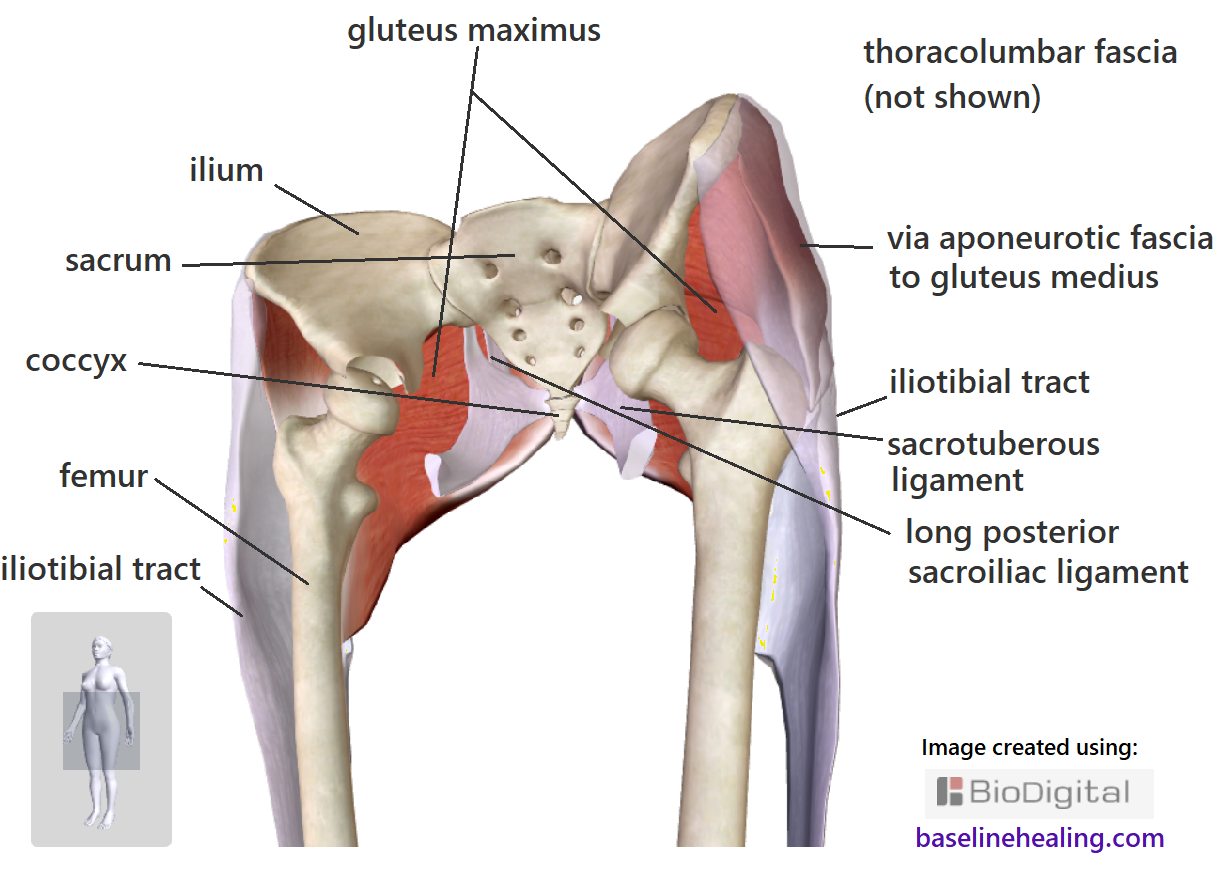
My comments.
The gluteus maximus muscles work in tandem with the rectus femoris muscles, stabilising the leg through a full range of movement.
The largest muscles of the body that position the leg to torso when fully engaged.
"Buns of steel" - Hands on buttocks. Feel these muscles contract and tighten.
The gluteus maximus muscles are superficial to, and surrounded by, a lot of anatomy prone to pain syndromes (caused by these main muscles not being adequately utilised?).

4. Rectus Femoris.
The rectus femoris muscles at situated at the front of each thigh, extending from pelvis to tibia.

The rectus femoris is traditionally described as part of the quadriceps femoris muscle group, along with the 3 vasti muscles (the vastus lateralis, vastus intermedius and vastus medialis).
The distal tendons of the 4 quadriceps muscles merge to form the common quadriceps tendon, which attaches to the patella (kneecap) and then continues as the patellar ligament to the tibial tuberosity of the tibia. i.e. the quadricep muscles share a common insertion but rectus femoris attaches to the pelvis, whilst the 3 vasti muscles attach to the femur. The rectus femoris is the only muscle of the quadriceps that crosses both the hip and knee joints
The pelvic attachments of the rectus femoris muscles are commonly described as "to the ilium of the pelvis via two heads - the straight head and the reflected head" but it is not that simple - variations in the pelvic attachments have been observed.
- The tendon of the straight head attaches to the anterior inferior iliac spine.
- The rectus femoris may also arise from the anterior superior iliac spine.
- The tendon of the reflected head attaches in a groove above the superior rim of the acetabulum and the fibrous capsule of the hip joint. The reflected head may be absent.
- A 3rd head may be present, attaching to the iliofemoral ligament deeply, and superficially to the gluteus minimus tendon as it attaches to femur.

The heads of the rectus femoris merge into an aponeurosis (a tough, thin sheet of connective tissue), from which the muscle fibres arise as the aponeurosis continues distally on the anterior surface of the muscle.
The lower two-thirds of the posterior surface of the rectus femoris consists of a thick, broad aponeurosis that becomes narrowed into a flattened tendon attached to the patella. This forms the superficial, central part of the common quadriceps tendon.
My comments.
The rectus femoris muscles - a strong pole down the front of the thigh when engaged along their full length. Positioning the leg to the pelvis and aligning the hip and knee joints.
Feel each muscle contract between it aponeuroses - think of pulling your kneecaps up and pushing down from your hip bone.
5. Trapezius.
- from mid-back (last thoracic vertebra - level with last rib)
- to the base of the skull
- extending out towards each shoulder
The left and right trapezius muscles are the most superficial muscle layer. Thin sheets of muscle that should be free to fully extend.

The trapezii (plural) meet midline, attaching to the nuchal ligament and supraspinous ligament.
The trapezii are sculpted down the neck and towards the shoulders, attaching to both scapula (shoulder blade) and clavicle (collar bone) of each arm - look at the shape.
Based on the direction of the muscle fibres, current descriptions split each trapezius muscle into 3 functional sections.

1. Upper trapezius. (a.k.a. superior trapezius, descending trapezius)
Attaches to:
- Base of the skull. External occipital protuberance and medial third of the superior nuchal line of the occipital bone via a thin fibrous lamina.
- Nuchal ligament.
- Lateral third of the clavicle.
- Spinal process of the 7th (last) cervical vertebra.
- Supraspinous ligament.
2. Middle trapezius. (a.k.a. transverse trapezius)
Attaches to:
- Spinal processes of the 1st to 4th thoracic vertebrae.
- Supraspinous ligament.
- Medial side of the acromion of the scapula.
3. Lower trapezius. (a.k.a. inferior trapezius, ascending trapezius)
Attaches to:
- The spinal processes of the 5th to 12th (last) thoracic vertebrae.
- Supraspinous ligament.
- Posterior crest of spine of the scapula.
- Deltoid tubercle of spine of the scapula.

Between the 6th cervical and 3rd thoracic vertebrae (the base of the nuchal ligament and start of the supraspinous ligament) the trapezius muscles are connected to the midline by a broad semi-elliptical aponeurosis, forming a tendinous ellipse between the shoulder blades.

My comments.
The trapezius muscles - from the back of the head to mid-back, extending out to each shoulder.
A kite-shaped blanket of muscle that should be smooth and wrinkle-free, supporting the head and arms through a full range of movement.
The trapezius muscles attach to the base of the skull via a thin sheet of connective tissue (lamina) and there is a ellipse of connective tissue at the base of the neck/between the shoulder blades too.
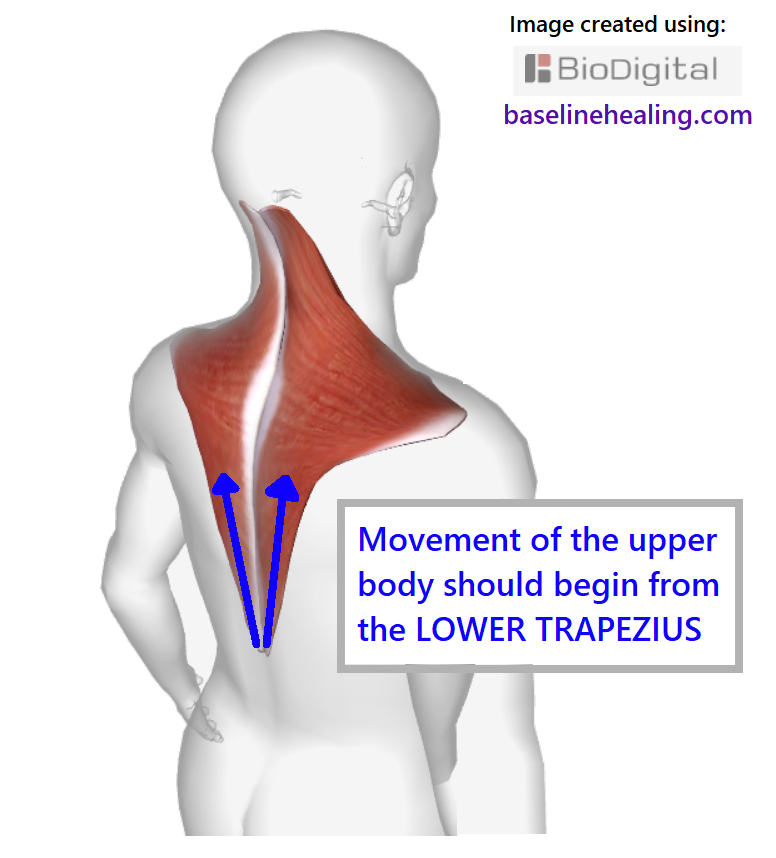
Movement of the upper body should begin from the lower trapezii. Think extension and expansion from midline outwards.
The middle trapezii should spread wide allowing the arms to fully extend. Our upper limb includes the scapula.
The upper trapezii should be free of tensions, allowing the head to move through its full range of movement and alignment of the nuchal ligament [LW · GW].


Base-Line Theory of Health and Movement (part 1).
Learning to use these 5 (paired - left and right) main muscles movement is the key to better health. - Physical and mental.
Everything starts from your Base-Line muscles:
Pelvic floor - Base.
Rectus abdominis - Line.

The body's Base-Line muscles are:
- From where the rest of the body extends. The rest of the body is positioned relative to Base-Line.
- Our muscular link to our 'primary guide for body alignment - the linea alba [LW · GW].
- Our core pillar of strength.
- Key to increasing our conscious proprioception [LW · GW] i.e. increased awareness of our sense of position, movement and balance.
- The main muscles to connect body and mind.

The Base-Line muscles should:
- Fully extend, aligning the linea alba.
- Flex and rotate at every level.
- Support the rest of the body through a full range of natural movement.
Think solid Base and strong, flexible Line. (see below for how to start 'breathing with your Base-Line').
- - -
Our Base-Line muscles are two of the '5 main muscles of movement' which, when fully utilised, provide the central framework for optimal [LW · GW] functioning of the body.

Connect Your Base-Line to Your Legs.
Gluteus maximus & rectus femoris.
It should be possible to move each leg through a full range of movement in a smooth and controlled manner, without effort or strain, possible when the gluteus maximus and rectus femoris muscles of each leg work in tandem.

Engagement of these leg muscles is about feeling them contract and strengthen. The rectus femoris a solid pole from shin to hip bone, aligning the hip and knee joints. The gluteus maximus the stabilising the legs to Base-Line support.
Aim for a full engagement of both muscles, left and right sides, balanced in all positions.
Connect Your Base-Line to Your Upper Body.
Trapezius.

- Do you have any connection to your trapezius muscles?
- Can you activate them from mid-back up? Pushing your shoulders up from under, not pulling them up from above?
- Can you feel your arms extend out from midline? Your shoulders free to move and rotate?
- Can you let your head relax forwards? Fully, without tension?
The whole of both trapezius muscles should be free to fully extend in all directions, without pain or tension, supporting the head and arms through a full range of movement.
The trapezius muscles align the nuchal & supraspinous ligaments when they are fully utilised. Our secondary references for body alignment.
A Simple Technique - Breathing with your Base-Line.
- Breathe in and up through your nostrils.
- Breathe out through your mouth.
- Engage your Base-Line muscles as you inhale.
- Begin with your Base pelvic floor.
Take as many breaths as you need to feel your pelvic floor muscles engaging. The base of the physical body and starting point of the body map [LW · GW] in the mind.
- Then activate your central Line - rectus abdominis muscles.
Think of engaging and elongating your rectus abdominis muscles section by section, in sequence from pelvis to chest.
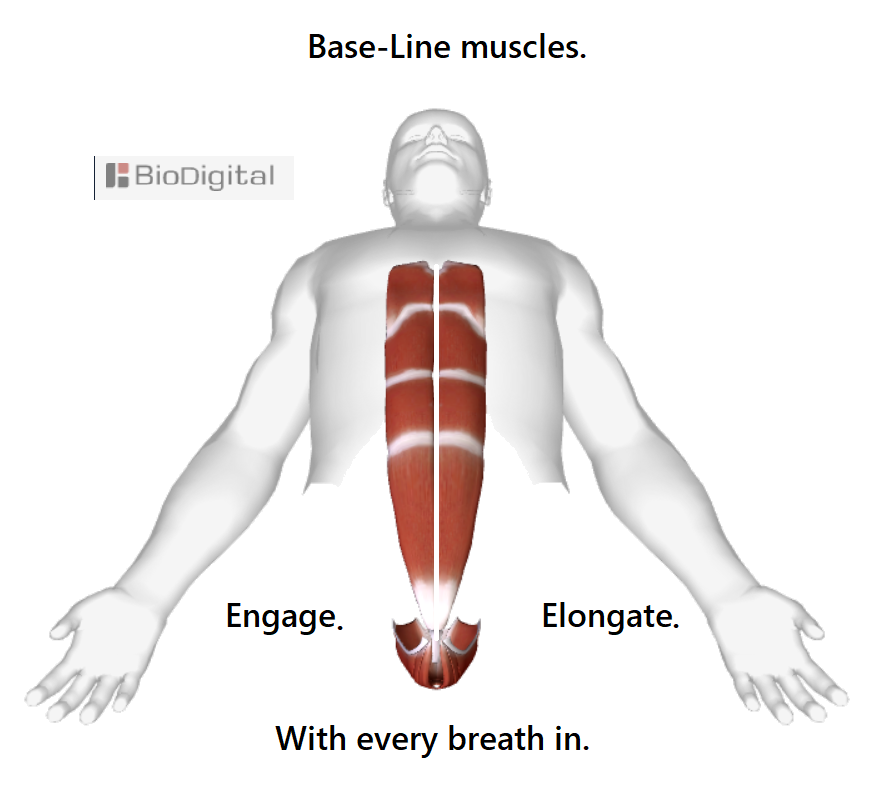
Stronger and longer with every in breath, extending the linea alba, our primary guide for body alignment.
Don't rush, just breathe. Wherever you are!
Be aware of when 'the wrong' areas of muscle [LW · GW] activate. When you feel this happening - relax, breathe and focus on your Base-Line muscles once more.
I used the roll-down [LW · GW] action a lot - my go-to move. Feeling my Base-Line supporting the rest of my body.
Don't worry about where your feet are to start, everything stems from your Base-Line.
----
Maintaining the body is not about doing specific exercises or reaching certain poses.
Work towards a full range of movement by focusing on these five main muscles, starting with your Base-Line.
Pelvic floor Base, rectus abdominis Line.
When these main muscles of movement are free to be fully utilised the rest 'falls into place' . The body is strong and movement flows when we can achieve dynamic alignment and balance. At least that's what I've found. I just need a few others to find out for themselves how lesswrong I am!
Part 3: Conscious Proprioception - Your Sense of Position, Movement & Balance. [LW · GW]
Background Notes on Muscles:
Muscle Engagement & Activation.
An 'active' muscle is traditionally is described as "contracting", but this implies a reduction in length or decrease in size which is often not the case.
The 3 standard classifications of how a muscle 'contracts' are:
- Concentric contraction - shortening of muscle tissue.
- Eccentric contraction - lengthening of muscle tissue.
- Isometric contraction - muscle length remains the same.
I prefer to use 'activating' and 'engaging' when it comes to discussing the usage of muscles. I like 'engaging' but I've had poor feedback. I continue my search for the perfect word - suggestions?!
Muscle Cells = Muscle Fibres.
Muscles consists of 'hundreds of thousands' (no figures available!) of elongated muscle cells (myocytes) surrounded by connective tissue. These cells are commonly known as muscle fibres.

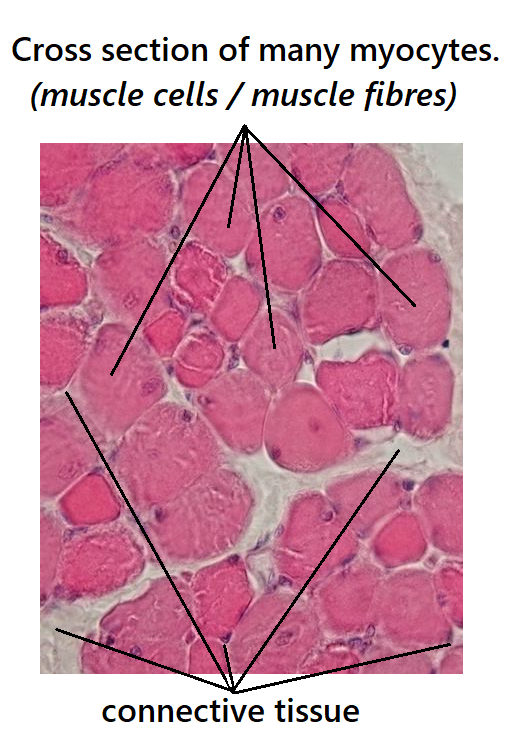
Areas of Muscle.
It is not "all or nothing" when a muscle works.
Muscles consist of many overlapping areas of potential activity. Some muscle fibres may be active whilst others are resting, or spasming in an individual muscle.

Voluntary Muscles.
Voluntary muscles are muscles with "an action that is under the control of the will".
All striated muscles (except the heart) are voluntary i.e. we can consciously control all our muscles if the connection between brain (command center) and muscle is developed.
Test Yourself ...
Are you willing to do a bit of self-experimentation and consider how your body moves?
Find the 5 main muscles of movement - palpate them on your body.
Can you connect with them? Feel them? Activate them?
It may take a while for 'activation signals' to to get to the right place, and the ability to fully engage the whole of a muscle comes with practice.
Time and effort.
To balance the body. And mind.
There are many idiopathic (of unknown cause) symptoms and syndromes associated with chronic pain. No known cause means no effective treatment. No relief for those who suffer. I believe that only when the main muscles of movement are being used correctly can their dysfunction be ruled out as the cause of the otherwise mysterious, painful symptoms experienced by so many.
10 comments
Comments sorted by top scores.
comment by Unreal · 2019-12-06T05:38:41.091Z · LW(p) · GW(p)
I appreciate seeing this post here! I am very interested in this sort of topic, generally.
I'm confused why the post has such a low karma score. If nothing else, it seems like a useful reference for human anatomy.
One thing this post suffers from is, like, it's overwhelming for a noob to look at. Personally I'd much rather just hire someone to teach me all this in person, if at all possible.
That said, it still seems like a great reference for parts of human anatomy, and it contains a very interesting hypothesis. I wish LessWrong talked more about this stuff, as it seems very important for humans and how humans think.
Writing about anything RE: biology, life, anatomy, etc. seems difficult because it's all very 3D in nature, and it's best to have good visualizations. Which are not always available. That said, I am grateful that you put all this together. It seems like it took a lot of work. And I hope to see more in the future.
Replies from: leggi↑ comment by leggi · 2019-12-07T09:20:01.622Z · LW(p) · GW(p)
Thank you for your comments. I was aiming to keep this anatomy post short and simple but that doesn't happen with words and anatomy (but it should be comprehensive and hopefully thought provoking)...
I've put together this post - 5 main muscles made easy [LW · GW].
I would very much appreciate feedback (harsh is fine if required!)
Is it an easier introduction? Does it help??
What makes sense? What clicks? What seems like waffle?!
Any images that work well? Any that are just confusing? Anything you'd like to see?
Would help understanding? Where have I gone wrong?
I'm struggling to judge the level to pitch things at. "palpate the anatomical structures" v. "touch yourself".
If you can find someone with a grounding in anatomy, get them consider these 5 muscles and how they use them for a while and then maybe they could teach you in person? I am very much in the "you can do it yourself" camp - it's all about feeling and personal experience but I can appreciate that guidance would be useful!
comment by ashen · 2019-10-06T10:55:32.915Z · LW(p) · GW(p)
Reminds me a bit of Will Johnson's stuff. E.g have a look here https://www.lionsroar.com/the-balanced-body-and-the-middle-way/amp/
Replies from: leggi↑ comment by leggi · 2019-10-08T10:55:29.688Z · LW(p) · GW(p)
Your comment invoked a whirlwind of emotion! From excitement and a "yay does someone else get it?" to my ego thinking "oh-no someone else has already figured this out" (and certain sense of relief when I read the article if I'm being totally honest).
The concept of body alignment and balance being a good thing is far from new (to be discussed a bit in further posts I'm working on).
I have spent the last couple of years searching to see if my perspective on the 'anatomy of alignment' is already out there but I've not found it, which still surprises me because
a) using the midline anatomy and the median plane as guides seems so obvious to me now
and
b) movement feels natural and 'right' now that I have learned to use my 'main muscles of movement'. Everything else falls into place.
I search for others who are willing to think about the state of activation and balance of these 5 main muscles .... to work on the connection between body and mind .... to start to feel what I mean.
Replies from: ashen↑ comment by ashen · 2019-10-11T10:48:42.534Z · LW(p) · GW(p)
Just to add more to my original comment and to your reply.
I was wondering to what extent this related to other somatic therapies, such as alexander technique, Feldenkrais etc.. e.g. https://www.yogajournal.com/practice/somatics-yogas-west
So there are lots of people who are not only willing to think about these kinds of things, but they base entire careers from this.
Parts of it also reminded me of Eric Goodman's "foundation training", such as breathing to decompress the torso - very much breathing as "longer and stronger".
In Lesswrong parlance, my impression of what you were proposing was that it was a fake framework [LW · GW]. So, for example, I don't really think there are "five main muscles of movement". Maybe there are 4, maybe 6. But acting as if there are 5 main muscles is useful.
In understanding your framework, I would want to understand to what extent it aligns and diverges from other frameworks. Where it has things in common, it probably is on more solid ground.
For example, some somatic people are obsessed with psoas muscles. I don't think your framework mentions them.. You mention linea alba as being important, but I don't recall others mentioning these as key. I am not sure what this means, but it makes me think that there isn't really anything special about the linea alba but its useful in your framework to consider it so.
Anyway, I enjoyed reading your three posts on this.
Replies from: leggi↑ comment by leggi · 2019-10-17T08:27:31.090Z · LW(p) · GW(p)
my impression of what you were proposing was that it was a fake framework [LW · GW].
I'm going to say no. This is not a fake framework. The '5 main muscles of movement' ARE the central muscular framework of the body. The muscles that, when free to fully function, allow a full range of natural movement and dynamic alignment of the body.
The muscles are paired - left and right sides - so technically that's 10 muscles - but 5 is the correct nomenclature, and sounds less daunting to anyone who doesn't know much anatomy.
The only fake framework is considering the pelvic floor muscles as one unit (of two halves). The anatomy of the pelvic floor is complicated, and the details unimportant to using these muscles so I'm happy to consider them as one muscle functionally.
I haven't come across/paid much attention to the term 'somatic therapy' before but it was interesting to see Pilates at the bottom of the list. I began this journey with Pilates classes and my hypothesis developed from my experiences and observations of trying to do Pilates exercises.
I believe Joseph Pilates figured out how to use his body correctly but didn't realise the underlying anatomy - the 5 main muscles to focus on. Looking at his original work return to life and what he called contrology (I can't pronounce that out loud!), 'the hundred' is the introductory exercise - there was no way could I have done that when I started - I couldn't even lift a leg of the ground without using my arms to pull it up.
I discovered the Base-Line muscles (pelvic floor, rectus abdominis) are the primary muscles to focus on to improve the usage of the body and also to develop our conscious proprioceptive skills so we can feel the condition and relative position of the body for ourselves.
You mention linea alba as being important, but I don't recall others mentioning these as key.
I haven't come across others mentioning the importance of the linea alba either. I am presenting a new perspective on the alignment of the body, grounded in the anatomy I hope! - it is.
The linea alba is important because:
- It part of our midline anatomy and the relative positioning of the midline anatomy is what we should use to judge the alignment of the body.
- It lies between the Base-Line muscles and so is the primary linear midline anatomical structure that we can become aware of by focusing on these muscles.
The nuchal and supraspinous ligaments (being linear midline structures as well) are also important markers for alignment, but everything extends from Base-Line...
some somatic people are obsessed with psoas muscles. I don't think your framework mentions them..
Many muscles get mentioned/obsessed over/are prone to syndromes and pain. But they are all secondary to the main muscles in my opinion, the muscles that are burdened when the central physical framework provided by the main muscles of movement is not adequate. We shouldn't look at things in isolation either (to be expanded in my next post).
... to what extent it aligns and diverges from other frameworks. Where it has things in common, it probably is on more solid ground
I don't feel the need to try and fit my hypothesis with other frameworks - there's a lot out there and I just don't have the time for a start. There are bits of truth in many things but this is 'the bigger picture'. I believe I am correct. I feel it. I know it. (I'm not sure where the line between confidence and arrogance lies but I'll go with confidence!)
Ultimately this is something to experience by focusing on the relevant anatomy and feeling for yourself, not for me to convince you of - although I very my appreciate your comments and questions - please keep them coming! I've just published my 4th post about [LW · GW]posture and poses [LW · GW]. (mostly definitions setting up for post 5).
Replies from: adrian-stanciu, ashen↑ comment by Adrian Stanciu (adrian-stanciu) · 2022-08-21T15:01:46.112Z · LW(p) · GW(p)
Very good reading to be honest.
I would have some questions:
- You say linea alba is important for alignment of the body. But this means alignment in the frontal plane (looking from the front), what about alignment in the sagittal plane (looking from the side) ?
- These are the main muscles for movement, but no matter how perfect they function, you cannot have natural movement without the stabilisers muscles working good as well.
- But I presume you are saying that if this muscles work correctly, every other muscles will function correctly as well. I cannot say you are wrong, I don't know the answer, but from my past experience I had issues with the traversus abdominis which is very important for lumbar stability. I could improve the rectus abdominis (superficial muscle) as much as I want, this didn't fix the problem for my deeper muscle, until I started concentrated on it.
- For some reason whenever I read about pelvic floor (in this article) I would always think about the traversus abdominis. For movement I feel this is much more important. But again, just my opinion, I don't have much information about the pelvic floor muscles.
Again, it was a nice reading. I rarely found someone opinions to be so intelligent when it comes to the human body.
↑ comment by ashen · 2019-10-28T07:37:10.641Z · LW(p) · GW(p)
Your argument against the idea that your belief that are 5 muscles of movement is a fake framework is a statement that that there are 5 muscles of movement. I don't find this convincing.
I mentioned there the psoas because of claims from some e.g. https://www.drnorthrup.com/psoas-muscle-vital-muscle-body/ :
The psoas muscle (pronounced SO-as) may be the most important muscle in your body. Without this essential muscle group you wouldn’t even be able to get out of the bed in the morning!
In fact, whether you run, bike, dance, practice yoga, or just hang out on your couch, your psoas muscles are involved. That’s because your psoas muscles are the primary connectors between your torso and your legs. They affect your posture and help to stabilize your spine.
The psoas muscles are made of both slow and fast twitching muscles. Because they are major flexors, weak psoas muscles can cause many of the surrounding muscles to compensate and become overused
i.e. some would put these in their list of "main muscles of movement". The psoas are harder to sense than some other muscles - and perhaps less useful for your framework. When I say fake framework, I don't mean what you are saying is obviously "wrong", but that is somewhat arbitrary and subjective (i.e. there is no clear dividing line in "nature" for minor vs. major muscle groups). As you say, thinking about 5 muscles gives you something to focus on to develop "conscious proprioceptive skills" - psoas are not good to focus on, hence not part of your five muscles of movement.
An argument to the contrary?
I don’t feel the need to try and fit my hypothesis with other frameworks—there’s a lot out there and I just don’t have the time for a start. There are bits of truth in many things but this is ‘the bigger picture’. I believe I am correct. I feel it. I know it.
When you talk about "discovering something" and "feeling" your are correct, my impression goes into "crackpot" terrority, claiming on generalities from n=1. I love crackpot theories, but for a site like LessWrong I think it is reasonable to hold you to higher epistemic standards, which is why I am on your back about this.
Anyhow, one thing that hit home with your writing. I sometimes try to reduce my head forward posture but engaging upper traps, with some glute activation.
When I try to do it more intuitively (in conjunction with thinking about your framework), I realise that I need to work bottom up. So that might involve lengthening of the quads, lengthening of the abs, and only then some trap engagement, but trying to use the lower traps more. This takes a while to do properly, so it helps to sync with breathing (breathing in long etc...).
Replies from: leggi, leggi↑ comment by leggi · 2019-10-28T10:53:29.415Z · LW(p) · GW(p)
Thank you for thinking about this framework and these muscles. Bit by bit see how it feels. I'm too excited to get on with other things so a longer answer:
The psoas....
"your psoas muscles are the primary connectors between your torso and your legs."
Primary connectors? A big statement, and I'd say no. A connection - yes, but looking at the anatomy (position/attachments/influence) of the psoas, versus a combination of 3 of the main muscles for movement: rectus abdominis, rectus femoris, gluteus maximus. What seems a 'better' system to move?, What muscles are capable of stabilising and connecting the leg (from pelvis to shin) and torso (from pelvis to thorax) through a full range of movement?
Edited to add anatomy from Gray's:
The Psoas major (Psoas magnus) is a long fusiform muscle placed on the side of the lumbar region of the vertebral column and brim of the lesser pelvis. It arises from the anterior surfaces of the bases and lower borders of the transverse processes of all the lumbar vertebræ from the sides of the bodies and the corresponding intervertebral fibrocartilages of the last thoracic and all the lumbar vertebræ by five slips, each of which is attached to the adjacent upper and lower margins of two vertebræ, and to the intervertebral fibrocartilage; from a series of tendinous arches which extend across the constricted parts of the bodies of the lumbar vertebræ between the previous slips; the lumbar arteries and veins, and filaments from the sympathetic trunk pass beneath these tendinous arches. The muscle proceeds downward across the brim of the lesser pelvis, and diminishing gradually in size, passes beneath the inguinal ligament and in front of the capsule of the hip-joint and ends in a tendon; the tendon receives nearly the whole of the fibers of the Iliacus and is inserted into the lesser trochanter of the femur.
Structurally, does a muscle that attaches to the lumbar spine and the femur seem a good idea as the primary connection between torso and legs?
"They affect your posture and help to stabilize your spine".
True. But 'secondary'. The psoas isn't meant to "take the strain" and the lumbar spine is prone to problems when muscles aren't used correctly.
"weak psoas muscles can cause many of the surrounding muscles to compensate and become overused"
Indeed. But I would argue that "weak" psoas ( over stressed?) comes with misusage of the 'main muscles of movement' and the imbalance and misalignment of the body.
thinking about 5 muscles gives you something to focus on to develop "conscious proprioceptive skills" - psoas are not good to focus on, hence not part of your five muscles of movement.
I'm not saying other muscles are unimportant (getting out of bed will be an issue if many individual muscles didn't function). I am saying that these 5 muscles are the main muscles to focus on to using to their full potential and are the primary 'support' and 'guides' to align and balance the body. (which is a good thing).
Finding my Base-Line was the key to developing my conscious proprioception. Having the sensory feedback about primary guide for alignment (linea alba), feeling my 'core pillar of strength' (It's hard not to resort to soundbites because they sum it up so well!)
The anatomy is all there. I believe it will stand up to the scrutiny of the biggest collection of rational thinkers I could find.
↑ comment by leggi · 2019-10-28T09:31:58.368Z · LW(p) · GW(p)
When you talk about "discovering something" and "feeling" your are correct, my impression goes into "crackpot" terrority, claiming on generalities from n=1. I love crackpot theories, but for a site like LessWrong I think it is reasonable to hold you to higher epistemic standards, which is why I am on your back about this.
Thank you! With all the karma I can bestow.
I know how it sounds. But I know I am right. I am but one let the ripples begin.
This is a rushed reply in a few minutes, I will answer in more detail when I can but I am on LW because hope for an audience that would:
- Question me, to help me develop my thoughts and explanations....
- Be curious enough to think about these 5 muscles. Look at the anatomy. Find the muscles on your body. Starting from Base-Line Try it. Feel it. Give it time.
pelvic floor Base. rectus abdominis Line - section by section. rectus femoris shin to hip. gluteus maximus solid and strong. trapezius wide and free.
That sums it up. Focus on these muscles and improve the physical state of the body.